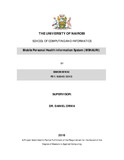| dc.description.abstract | HIV and Aids has been identified worldwide as one of the main causes of reduced economic
growth in most of the developing countries. This is because a lot of resources are diverted in
health care provision to patient living with HIV and AIDS which also reduces personal
output. Due to the devastating effect of HIV/AIDS, the government in 1999, declared
HIV/AIDS a national disaster and established National AIDS Control Council (NACC) to
coordinate a multisectoral fight against the pandemic (World bank, 2005). This enabled the
government to avail enough resources and manpower in the fight against the spread of this
disease.
Kenya has achieved much in the areas of ARV dispensation, educating people on HIV and
AIDS prevention and care. However one of the biggest problem affecting HIV and AIDS
treatment is funding. Most of the organisations dealing with HIV and AIDS including the
government still relying on donor funding to meet medication needs for their patients; due to
this Most of the CCC’S are unable to provide patient medication requirement for the required
duration of three months.
Kenya is a transit country for Eastern and Central Africa, Hence there are a lot of migratory
HIV and AIDS patient moving from one country to another especially truck drivers when
delivering goods from Mombasa main port to the other parts of Eastern and central Africa.
Due to this most of them spend more than three month on transit. This is more than
medication provided. Usually ARV are provided for three months some of which it’s not
possible due to their cost. This is one of the hindrance to reducing diseases caused by HIV
and AIDS such as TB. To reduce this issue there are several CCC cares across the countries
but due to lack of CCCs interoperability patients are not able to obtain medication when on
transit due to lack of their treatment historical data which is very important for any
medication to be provided.
With the growth of mobile technology in world, this issue can be eliminated by ensuring that
patient information which is normally captured and transmitted to NASSCOP is stored
centrally. If a patient visit any CCC no need for providing any hardcopies document, use of
guess or information stored as draft messages on their mobile phones. Using our personal
health information mobile system, the patient system provides their patient identification
number which is sent as a sms and a response is sent back to the clinician with the previous
crucial services provided to the patient and the patient is provided with the required services.
V
The issue of patient visiting their origin CCC of registration in order to get all services is
eradication because as long as their information maintained centrally they can obtain
information from any CCCs.
From our system testing if patient information has been stored correctly and also clinician
information maintained in the system, security of patient data is maintained, nobody is able to
obtain patient data and also patient cannot request for His/her information. | en_US |

